Journalism
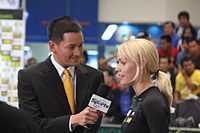
"Journalism is a method of inquiry and literary style that aims to provide a service to the public by the dissemination and analysis of news and other information."[1]
Theory of journalism
Def.
- the "aggregating, writing, editing, and presenting of news or news articles for widespread distribution, typically in periodical print publications and broadcast news media, for the purpose of informing the audience"[2] or
- the "style of writing characteristic of material in periodical print publications and broadcast news media, consisting of direct presentation of facts or events with an attempt to minimize analysis or interpretation"[2]
is called journalism.
Entities
"Hegemonic leadership could also be provided by subordinated groups or classes in order to resist the ideas and actions of the dominant group."[3]
Arts journalism
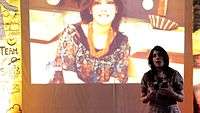
On the right a journalist highlights the idea of bringing arts journalism into the mainstream media and its importance in current times.
Broadcast journalism
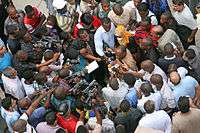
On the right, Police Commissioner Suleiman Kova answers and addresses the media at ground zero near the 2013 Dar es Salaam building collapse.
Business journalism

A television reporter interviews a corporate chief executive officer (CEO) in the image on the right.
Entertainment journalism
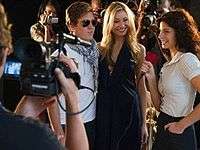
In the image on the right an entertainment journalist on the right interviews a couple of entertainers before cameras.
Fashion journalism

In the image on the right, a fashion journalist interviews a fashion model on camera.
Investigative journalism

Def. a "form of journalism in which the reporter deeply investigates a single topic of interest, often involving crime or corruption"[4] is called investigative journalism.
"Reporting, through one's own initiative and work product, matters of importance to readers, viewers, or listeners [is investigative journalism]."[5]
"An investigative journalist is a man or woman whose profession it is to discover the truth and to identify lapses from it in whatever media may be available. The act of doing this generally is called investigative journalism and is distinct from apparently similar work done by police, lawyers, auditors, and regulatory bodies in that it is not limited as to target, not legally founded and closely connected to publicity."[6]
Medical journalism

On the right is a photo of Danielle Krol, MD, calling a researcher that conducted the study she will report on.
Political journalism

President Richard M. Nixon, USA, poses with members of the press during his trip to Shanghai, China on 28 February 1972.
Sports journalism

Sports reporters converge on Marcos René Maidana at right after his victory in Buenos Aires, Argentina on September 23, 2011.
Technology journalism
.jpg)
On the right, tech journalism reporter Joshua Topolsky interviews Julie Uhrman about OUYA! at SZSW.
Video-game journalism
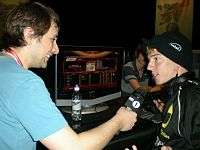
In the image at right Shaun Clark is interviews by a British Broadcasting Company reporter regarding Team Dignitas.
War journalism
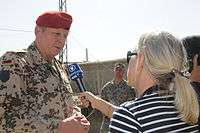
In the image on the right, Marion von Haaren, a correspondent for the German public television station ARD interviews German Army General Karl-Heinz Lather, chief of staff of Supreme Headquarters Allied Powers Europe, Allied Command Operations, NATO, after a mission briefing Oct. 7, 2009, at Forward Operating Base Ghazni, Afghanistan.
Research
Hypothesis:
- The dominant group in journalism determines the course and focus of journalists.
Control groups

The findings demonstrate a statistically systematic change from the status quo or the control group.
“In the design of experiments, treatments [or special properties or characteristics] are applied to [or observed in] experimental units in the treatment group(s).[7] In comparative experiments, members of the complementary group, the control group, receive either no treatment or a standard treatment.[8]"[9]
Proof of concept
Def. a “short and/or incomplete realization of a certain method or idea to demonstrate its feasibility"[10] is called a proof of concept.
Def. evidence that demonstrates that a concept is possible is called proof of concept.
The proof-of-concept structure consists of
- background,
- procedures,
- findings, and
- interpretation.[11]
See also
- School:Journalism
References
- ↑ "Journalism, In: Wikipedia". San Francisco, California: Wikimedia Foundation, Inc. May 6, 2014. Retrieved 2014-05-06.
- 1 2 "journalism, In: Wiktionary". San Francisco, California: Wikimedia Foundation, Inc. April 20, 2014. Retrieved 2014-05-06.
- ↑ Christine Cooper (June 1995). "Ideology, hegemony and accounting discourse: a case study of the National Union of Journalists". Critical Perspectives on Accounting 6 (3): 175-209. doi:10.1006/cpac.1995.1019. http://www.sciencedirect.com/science/article/pii/S1045235485710192. Retrieved 2014-05-06.
- ↑ "investigative journalism, In: Wiktionary". San Francisco, California: Wikimedia Foundation, Inc. March 1, 2014. Retrieved 2014-05-06.
- ↑ Steve Weinberg, The Reporter's Handbook: An Investigator's Guide to Documents and Techniques, St. Martin's Press, 1996
- ↑ Investigative Journalism: Context and Practice, Hugo de Burgh (ed), Routledge, London and New York, 2000
- ↑ Klaus Hinkelmann, Oscar Kempthorne (2008). Design and Analysis of Experiments, Volume I: Introduction to Experimental Design (2nd ed.). Wiley. ISBN 978-0-471-72756-9. http://books.google.com/?id=T3wWj2kVYZgC&printsec=frontcover.
- ↑ R. A. Bailey (2008). Design of comparative experiments. Cambridge University Press. ISBN 978-0-521-68357-9. http://www.cambridge.org/uk/catalogue/catalogue.asp?isbn=9780521683579.
- ↑ "Treatment and control groups, In: Wikipedia". San Francisco, California: Wikimedia Foundation, Inc. May 18, 2012. Retrieved 2012-05-31.
- ↑ "proof of concept, In: Wiktionary". San Francisco, California: Wikimedia Foundation, Inc. November 10, 2012. Retrieved 2013-01-13.
- ↑ Ginger Lehrman and Ian B Hogue, Sarah Palmer, Cheryl Jennings, Celsa A Spina, Ann Wiegand, Alan L Landay, Robert W Coombs, Douglas D Richman, John W Mellors, John M Coffin, Ronald J Bosch, David M Margolis (August 13, 2005). "Depletion of latent HIV-1 infection in vivo: a proof-of-concept study". Lancet 366 (9485): 549-55. doi:10.1016/S0140-6736(05)67098-5. http://www.ncbi.nlm.nih.gov/pmc/articles/PMC1894952/. Retrieved 2012-05-09.
External links
- African Journals Online
- Bing Advanced search
- Google Books
- Google scholar Advanced Scholar Search
- JSTOR
- Lycos search
- Office of Scientific & Technical Information
- PsycNET
- Questia - The Online Library of Books and Journals
- SAGE journals online
- Scirus for scientific information only advanced search
- SpringerLink
- Taylor & Francis Online
- Wiley Online Library Advanced Search
- Yahoo Advanced Web Search
| |||||||||||||||||||||||||||||||||||||||||||||||||||||
| ||||||||||||||||||||||||||||||||||||||||||||||||||||||||||||||
| |||||||||||||||||||||||||||||||||||||||||||||||||||||
| ||||||||||||||||||||||||||||||||||||||||||||
![]() This is a research project at http://en.wikiversity.org
This is a research project at http://en.wikiversity.org
| |
Development status: this resource is experimental in nature. |
| |
Educational level: this is a research resource. |
| |
Resource type: this resource contains a lecture or lecture notes. |
| |
Subject classification: this is a communication resource. |
| |
Subject classification: this is a humanities resource. |
| |
Subject classification: this is a literature resource. |